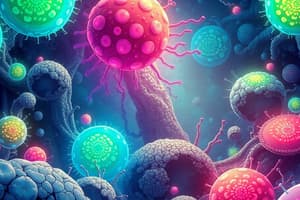Podcast
Questions and Answers
Explain the process of methanogenesis.
Explain the process of methanogenesis.
Methanogenesis is the process of producing methane from carbon dioxide and hydrogen. The reaction can be represented as CO2 + 4H2 -> CH4 + 2H2O. It is carried out by a group of archaea called methanogens.
Name two groups of phototrophic organisms based on the presence or absence of oxygen as a byproduct of photosynthesis.
Name two groups of phototrophic organisms based on the presence or absence of oxygen as a byproduct of photosynthesis.
Phototrophic organisms can be divided into two groups based on the presence or absence of oxygen as a byproduct of photosynthesis: anoxygenic phototrophs and oxygenic phototrophs.
Provide examples of anoxygenic phototrophs and their respective byproducts of photosynthesis.
Provide examples of anoxygenic phototrophs and their respective byproducts of photosynthesis.
Examples of anoxygenic phototrophs include purple bacteria, which produce hydrogen from water and carbon dioxide, and green sulfur bacteria, which produce sulfur from hydrogen sulfide and carbon dioxide.
List examples of oxygenic phototrophs and describe their significance.
List examples of oxygenic phototrophs and describe their significance.
Explain the basic steps of photosynthesis in green bacteria, purple bacteria, and cyanobacteria.
Explain the basic steps of photosynthesis in green bacteria, purple bacteria, and cyanobacteria.
What are the main differences between green bacteria, purple bacteria, and cyanobacteria in terms of the type of pigment they use to absorb light energy?
What are the main differences between green bacteria, purple bacteria, and cyanobacteria in terms of the type of pigment they use to absorb light energy?
Explain the significance of methanogens in the process of methanogenesis.
Explain the significance of methanogens in the process of methanogenesis.
What is the role of phototrophic organisms in synthesizing organic molecules?
What is the role of phototrophic organisms in synthesizing organic molecules?
How do anoxygenic phototrophs differ from oxygenic phototrophs in terms of the byproducts of photosynthesis?
How do anoxygenic phototrophs differ from oxygenic phototrophs in terms of the byproducts of photosynthesis?
What are the similarities and differences in the habitats of cyanobacteria, green algae, and plants?
What are the similarities and differences in the habitats of cyanobacteria, green algae, and plants?
How does the absorption of light energy differ among green bacteria, purple bacteria, and cyanobacteria?
How does the absorption of light energy differ among green bacteria, purple bacteria, and cyanobacteria?
What is the significance of producing oxygen as a byproduct of photosynthesis in oxygenic phototrophs?
What is the significance of producing oxygen as a byproduct of photosynthesis in oxygenic phototrophs?
What is the chemical equation for hydrogen oxidation?
What is the chemical equation for hydrogen oxidation?
Name two examples of aerobic chemolithotrophs and describe their oxidation reactions.
Name two examples of aerobic chemolithotrophs and describe their oxidation reactions.
Give examples of anaerobic chemolithotrophs and the inorganic compounds they use for energy-producing reactions.
Give examples of anaerobic chemolithotrophs and the inorganic compounds they use for energy-producing reactions.
What is the energy source for chemolithotrophs?
What is the energy source for chemolithotrophs?
Explain the difference between aerobic and anaerobic chemolithotrophs in terms of electron acceptors.
Explain the difference between aerobic and anaerobic chemolithotrophs in terms of electron acceptors.
What is the process of oxidizing hydrogen to water known as?
What is the process of oxidizing hydrogen to water known as?
Define chemolithotrophs and their source of carbon.
Define chemolithotrophs and their source of carbon.
Give an example of an iron bacteria and describe its oxidation reaction.
Give an example of an iron bacteria and describe its oxidation reaction.
Explain the significance of the oxidation reactions carried out by chemolithotrophs.
Explain the significance of the oxidation reactions carried out by chemolithotrophs.
What is the role of oxygen in the energy-producing reactions of aerobic chemolithotrophs?
What is the role of oxygen in the energy-producing reactions of aerobic chemolithotrophs?
Describe the process of methane production by methanogens.
Describe the process of methane production by methanogens.
How can the energy released by hydrogen oxidation be utilized by organisms?
How can the energy released by hydrogen oxidation be utilized by organisms?
Define chemolithotrophs and explain how they obtain carbon for synthesizing organic molecules.
Define chemolithotrophs and explain how they obtain carbon for synthesizing organic molecules.
Give examples of aerobic chemolithotrophs and describe their energy-producing reactions.
Give examples of aerobic chemolithotrophs and describe their energy-producing reactions.
What are anaerobic chemolithotrophs and how do they differ from aerobic chemolithotrophs?
What are anaerobic chemolithotrophs and how do they differ from aerobic chemolithotrophs?
Explain the role of Nitrosomonas and Nitrospira in the context of aerobic chemolithotrophy.
Explain the role of Nitrosomonas and Nitrospira in the context of aerobic chemolithotrophy.
How do sulfur bacteria contribute to aerobic chemolithotrophy?
How do sulfur bacteria contribute to aerobic chemolithotrophy?
Describe the energy-producing reactions of iron bacteria as aerobic chemolithotrophs.
Describe the energy-producing reactions of iron bacteria as aerobic chemolithotrophs.
What are the main characteristics of anaerobic chemolithotrophs?
What are the main characteristics of anaerobic chemolithotrophs?
Provide examples of anaerobic chemolithotrophs and explain their energy-producing reactions.
Provide examples of anaerobic chemolithotrophs and explain their energy-producing reactions.
What is hydrogen oxidation and how is it relevant to chemolithotrophy?
What is hydrogen oxidation and how is it relevant to chemolithotrophy?
How does the reaction for hydrogen oxidation look like?
How does the reaction for hydrogen oxidation look like?
What is the significance of the oxidation of inorganic compounds in the context of chemolithotrophy?
What is the significance of the oxidation of inorganic compounds in the context of chemolithotrophy?
Why is the ability to use inorganic compounds as electron acceptors important for chemolithotrophs?
Why is the ability to use inorganic compounds as electron acceptors important for chemolithotrophs?
Flashcards are hidden until you start studying




